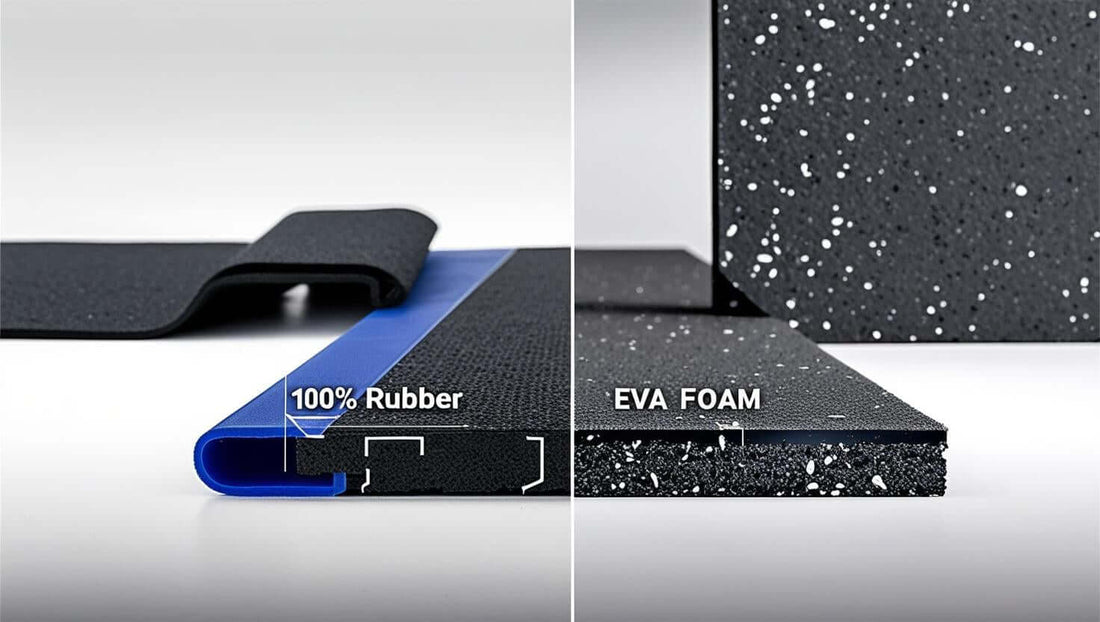
Foam Vs Rubber: Which One is Right for You?
Share
100% Rubber Mats vs. EVA Foam with Rubber Top
Choosing the right gym flooring is crucial for safety, durability, and performance. Two popular options are 100% rubber interlocking mats and EVA foam composite mats.
While both types offer protection for your floors, they perform very differently when it comes to stability, shock absorption, and long-term use.
Let’s hop right in and compare these two popular choices!
1. Durability & Longevity
Gym flooring needs to withstand constant impact, heavy weights, and intense workouts.
-
100% Rubber Interlocking Mats are built to last. They are resistant to wear, tear, and compression, making them ideal for high-impact training and commercial or home gyms. They won’t dent under heavy weights and are highly resilient over time.
-
EVA Foam Mats, on the other hand, compress and break down quickly, especially under pressure. They may dent, tear, or become uneven with repeated use, making them unsuitable for long-term durability.
🏆 Winner: 100% Rubber Flooring (Best for long-term durability and heavy-duty use)
2. Stability & Joint Protection
A stable surface is critical for safe and effective movement.
-
100% Rubber Interlocking Mats provide excellent stability and grip, keeping your feet firmly planted during workouts. Their heavier weight and interlocking design prevent movement, ensuring that the surface remains steady even under intense exercise.
-
EVA Foam Mats may feel soft at first, but their lightweight nature causes them to shift during workouts. This instability can increase the risk of joint injuries, as the uneven surface forces your ankles, knees, and hips to compensate for movement. This makes them a poor choice for any exercise involving movement, balance, or impact.
✅ Best for Body Movement & Joint Safety: 100% Rubber Flooring
❌ Avoid for Body Movement & Stability: Rubber + EVA Foam Flooring
🏆 Winner: 100% Rubber Flooring (Best for balance, grip, and preventing injuries)
3. Shock Absorption & Impact Protection
The ability to absorb impact is important for protecting both your body and your flooring.
-
100% Rubber Mats are dense and firm, which helps absorb impact without excessive compression. This makes them perfect for weightlifting, plyometrics, and high-intensity workouts, as they provide both protection and stability.
-
EVA Foam Mats compress too much under pressure, which can lead to an unstable surface. This makes them less effective for shock absorption and more likely to cause imbalance or discomfort during workouts.
🏆 Winner: 100% Rubber Flooring (Best for shock absorption and joint protection)
4. Noise & Vibration Reduction
If your gym is in a home, apartment, or shared space, controlling noise and vibrations is important.
-
100% Rubber Mats excel at reducing noise and impact vibrations, especially in thicker versions (⅜ inch or more). They dampen the sound of dropped weights and heavy movements, making them ideal for home use.
-
EVA Foam Mats provide some noise reduction, but since they compress more, they don’t absorb sound as effectively as rubber mats do.
🏆 Winner: 100% Rubber Flooring (Best for sound and vibration control)
5. Water & Sweat Resistance
Gyms are high-moisture environments, so flooring must be water-resistant and easy to clean.
-
100% Rubber Mats are naturally water-resistant. They do not absorb sweat, making them easy to wipe down and maintain, reducing the risk of odors and bacterial growth.
-
EVA Foam Mats have a porous foam layer that can absorb sweat and moisture, leading to unpleasant odors and making them harder to clean.
🏆 Winner: 100% Rubber Flooring (Best for hygiene and maintenance)
6. Price & Installation
Cost and ease of setup are key considerations when choosing gym flooring.
-
EVA Foam Mats are cheaper upfront and come in lightweight interlocking tiles that are easy to install. However, their lack of durability means they need to be replaced more often, making them a less cost-effective long-term option.
-
100% Rubber Interlocking Mats are heavier but just as easy to install. Thanks to their interlocking edges, they do not require adhesives or double-sided tape, making them a simple and secure option for any gym. Though they have a higher initial cost, their long lifespan makes them a better investment.
🏆 Winner: EVA Foam (for short term solutions) Rubber Flooring (More cost-effective in the long run)
Final Verdict: Which One Should You Choose?
| Feature | 🏆 Best Choice |
|---|---|
| Durability & Longevity | 100% Rubber |
| Stability & Joint Protection | 100% Rubber |
| Shock Absorption | 100% Rubber |
| Sound & Vibration Reduction | 100% Rubber |
| Water & Sweat Resistance | 100% Rubber |
| Price & Installation | 100% Rubber (Better Long-Term Investment) |
Why 100% Rubber Interlocking Mats Are the Best Choice:
✔ Maximum durability for weightlifting, high-impact training, and heavy equipment.
✔ Non-slip, stable surface that won’t shift under movement.
✔ Safer for joints and body movement exercises (no instability issues like EVA foam).
✔ Excellent noise and vibration reduction, ideal for home gyms.
✔ Water-resistant and easy to clean (no sweat absorption like foam).
✔ Easy to install with an interlocking system—no adhesives required.
✔ Better long-term investment (lasts longer and requires fewer replacements).
Why You Should Avoid Rubber + EVA Foam Mats:
❌ Unstable and prone to shifting, increasing the risk of injury.
❌ Soft foam compresses too much, making workouts unsafe and uncomfortable.
❌ Wears down quickly, requiring frequent replacement.
❌ Absorbs sweat and odors, making maintenance difficult.
The Bottom Line:
If you're looking for safe, long-lasting, and stable flooring for all types of workouts, 100% rubber interlocking mats are the clear winner. While EVA foam mats may seem appealing due to their low price and initial softness, their lack of stability and durability makes them a poor choice for serious training—and even dangerous for exercises involving movement.
For the best results, invest in 100% rubber flooring—your joints (and your gym) will thank you.
